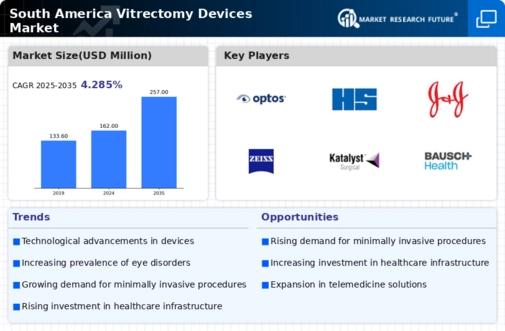The South America Vitrectomy Devices Market is characterized by a competitive landscape that showcases a diverse array of players focusing their strategies on innovation, market expansion, and customer engagement. This market is evolving rapidly, driven by technological advancements and an increasing prevalence of eye-related disorders. Companies within this sector are investing significantly in research and development to enhance their product offerings, which include vitrectomy packs, trays, and specialized surgical instruments tailored for ophthalmic surgery.
The market dynamics are further influenced by factors such as regulatory changes, pricing strategies, and the growing demand for minimally invasive procedures. This results in a highly competitive environment where companies strive to establish a strong foothold. Optos is renowned in the realm of eye care, particularly within the South American Vitrectomy Devices Market, where it has built a solid reputation with its advanced retinal imaging technology.
The company's strength lies in its ability to deliver high-resolution images that support early diagnosis and treatment of various ocular conditions. In South America, Optos has successfully leveraged its innovative technologies to cater to a growing awareness of eye health among patients and healthcare providers. The brand is recognized for its commitment to improving patient outcomes, and its established partnerships with clinics and hospitals across the region bolster its market presence. Optos’s focus on continuous improvement and advancement in imaging technology positions it favorably in a competitive market where quality and high standards are paramount.
PrecisionEye plays a significant role within the South American Vitrectomy Devices Market, offering cutting-edge products designed for various eye surgical applications. The company specializes in vitrectomy machinery and supporting instruments that enable precision surgeries for patients suffering from retinal diseases. PrecisionEye's strengths lie in its robust product lineup, which includes state-of-the-art vitrectomy systems and consumables that are essential for modern ophthalmic procedures.
With its strategic marketing initiatives and collaborations with regional healthcare institutions, PrecisionEye has established a notable market presence. In recent years, the company has announced several partnerships aimed at expanding its distribution network, and this focus on mergers and acquisitions strengthens its competitive position, allowing it to extend its reach and enhance the accessibility of its products across South America.


















Leave a Comment